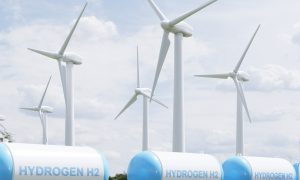India expedites development of green hydrogen production infrastructure

India is accelerating its renewable energy transition with initiatives like the trial of its first hydrogen-powered train in December, NTPC’s solar hydrogen microgrid in Ladakh, and green hydrogen production at Paradip Port. The National Green Hydrogen Mission aims to produce 5 million tonnes annually by 2030. Government incentives, indigenous technology, and global collaborations drive India’s leadership in green energy.
New Delhi: India is trying to scale up renewable capacity at an unprecedented pace, positioning the country as one of the global leaders in energy transition. For instance, the Indian Railways is set to trial its first hydrogen-powered train this December. Manufactured by the Integral Coach Factory in Tamil Nadu, and designed to run at speeds up to 140 kilometres per hour the train uses fuel cells that combine hydrogen and oxygen to generate electricity, with water vapour as the only emission. The trial run will take place on the Jind-Sonipat route in Haryana, covering a distance of 90 kilometres. If the trial is successful, India plans to introduce 35 more hydrogen-powered trains by 2025 to its railway network. This aligns with the Indian government goal of achieving net-zero carbon emissions by 2030.
Recently, for the first time in the world energy transition company Jakson Green has synthesised methanol captured from Co2 flue gases using a synthesis process as part of a pilot project at India’s leading power generation company, National Thermal Power Corporation’s (NTPC) Vindhyachal Thermal Power Plant.
NTPC Green Energy, which has an installed capacity of 3,220 MW right now, is aiming to take up the same number to 6,000 MW by March 2025, 11,000 MW by March 2026 and 19,000 by March 2027.
India’s first multi-purpose green hydrogen pilot project at 1,500 MW Nathpa Jhakri Hydro Power Station (NJHPS) in Himachal’s Jhakri was inaugurated earlier in April this year. The project was the nation’s first multi-purpose (combined heat and power) green hydrogen generation plant with the capability to cater to the high-velocity oxygen fuel (HVOF) coating facility of NJHPS to meet its combustion fuel requirements, in addition to generating electricity through its 25kW capacity fuel cell.
Located on the Bay of Bengal in the state of Odisha, India’s Paradip Port plans to develop an exclusive green hydrogen and green ammonia berth for its export and bunkering with a capacity of 5 million tonnes per annum (MPTA), as part of the port’s strategy to become fully mechanized by 2030.
Similar renewable energy solutions are happening across various sectors in India. In October this year state-owned power generator NTPC announced that it had partnered with the Indian Army to set up a Solar Hydrogen-based Microgrid at Chushul, Ladakh, to provide stable power supply using Green Hydrogen in off-grid Army locations.
Aligned with the National Green Hydrogen Mission of the Government of India, such projects are poised to accelerate the development of green hydrogen production infrastructure in India’s power sector. Union Minister Nitin Gadkari has hailed hydrogen as the future fuel, promoting green fuels in India. He envisions ethanol-based vehicles dominating the market, leading to job creation in agriculture.
Hydrogen, particularly green hydrogen, is being viewed as the next big alternate source of energy revolution. Since green hydrogen is proven to release little to no greenhouse gases, it has become highly favoured. In terms of energy requirements, India’s economy is currently the third largest in the world, and it is estimated that by 2030, the nation’s demand for energy is expected to increase by 35 percent.
India’s National Green Hydrogen Mission, which was launched in January 2023 with an overall outlay of Rs 19,744 crores aims to develop a green hydrogen production capacity of at least 5 million tonnes per year with an associated renewable energy capacity addition of about 125 GW in the country. At present, non-fossil fuel-based capacity constitutes about 42% of India’s installed energy generation. The government aims to raise the share of non-fossil fuel in India’s electricity generation capacity to 50% by 2030.
Nearly Rs 40 million has been allocated for research and development activities for 2025–26, and US$2.1 billion is allocated to the Strategic Interventions for Green Hydrogen Transition (SIGHT) scheme, which provides incentives for the production of green hydrogen. As part of the Green Hydrogen Mission, the government is also aiming to develop a skilled workforce of about 600,000 people over the next six years.
The technology for hydrogen production is developed indigenously and has high local material content. Recently, Bharat Heavy Electricals Limited (BHEL) has entered into a Technology Transfer Agreement (TTA) with Bhabha Atomic Research Centre (BARC) for a 50 kW alkaline electrolyzer system for Hydrogen production. This is a crucial step in terms of scaling up Indigenous Alkaline Electrolyser Technology and its commercialization for application in sectors such as refineries, fertilizer, steel, transportation, etc. Reliance Industries has also entered into a technology licensing agreement with Oslo-based Nel Hydrogen Electrolyser AS for manufacturing electrolyzers.
The primary goal of the mission is to position India as the leading global hub for the production, utilization, and export of green hydrogen and its derivatives. Green energy alliances are also being initiated at state levels. Power giant NTPC, has entered into a pact with Mahatma Phule Renewable Energy and Infrastructure Technology (MAHAPREIT) for the development of renewable energy parks and projects in Maharashtra. The agreement envisages joint development of grid-connected renewable energy parks and projects including solar, wind, hybrid etc. and/or solutions thereof up to 10 GW in Maharashtra.
In keeping with the goals set for an increase in green hydrogen, the government recently exempted solar and wind energy plants located in a special economic zone (SEZ), or export-oriented units for the production of green hydrogen and its derivatives that are also in the same zone, from buying modules and turbines from the approved list of models and manufacturers. According to a May 28, 2024 notification by the Ministry of New and Renewable Energy, the exemption will apply to the renewable energy plants to be commissioned by December 2030 to produce green hydrogen and its derivatives.
Under the existing foreign direct investment (FDI) policy of the Government of India, the renewable energy sector allows up to 100 percent FDI under the automatic route. The Boston Consulting Group (BCG) in its report “The Next ‘Digital’: Unlocking a $50 Billion Green Tech Opportunity,”(2022) has projected that the green tech sector in India will achieve a market size of US$45-55 billion by 2027. The report highlights that the growth of green technology is spurred by the increasing adoption of sustainable applications across IoT (Internet of Things), cloud computing, data platforms & analytics, digital twin (digital model of an intended or actual real-world physical product, system, or process), and blockchain.
This month (Nov 12, 2024) the ambassadors from the European Union, Germany, Denmark and Belgium renewable energy park in Khavda, Gujarat, where the Adani Group has built the world’s largest renewable energy park, with a planned capacity of 30 GW, encompassing solar and wind energy projects over an area over five times larger than Paris. Adani outlined to the visiting diplomats the group’s ambitious plans to scale up green hydrogen production, aiming to meet the European Union’s Renewable Fuels of Non-Biological Origin (RFNBO) requirements.
Finally, aside from explicitly encouraging investment in hydrogen technology, the Indian government is trying to address major issues like high costs, policy and technology uncertainty, value chain complexity and infrastructure requirements, regulations and standards, and public acceptance of fuel sources free of emissions. The country’s ambition to produce 5 million metric tons (mt) of renewable hydrogen by 2030 and secure a 10 per cent share of the global trade by that time underscores its commitment to renewable energy. In an effort to search for innovative funding mechanisms to sustain renewable energy growth within private-sector-driven models, government think tank NITI Aayog, in collaboration with India’s Ministry of power and Ministry of new and renewable energy, has launched the ASSET platform (Accelerating Sustainable Solutions for Energy Transition) to support states in accelerating their green transition. This is a recognition that the role of states is crucial in achieving India’s national aspirations of achieving net-zero greenhouse gas emissions by 2070.
To read more about Ethanol Industry News, continue reading Agriinsite.com
Source Link : Times Of Oman

















